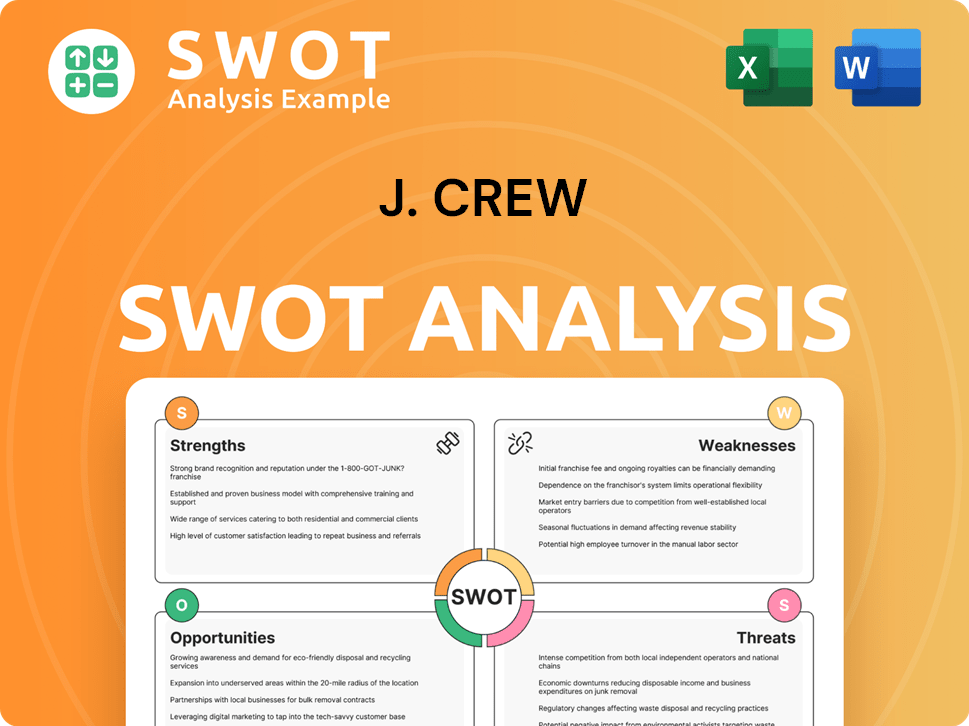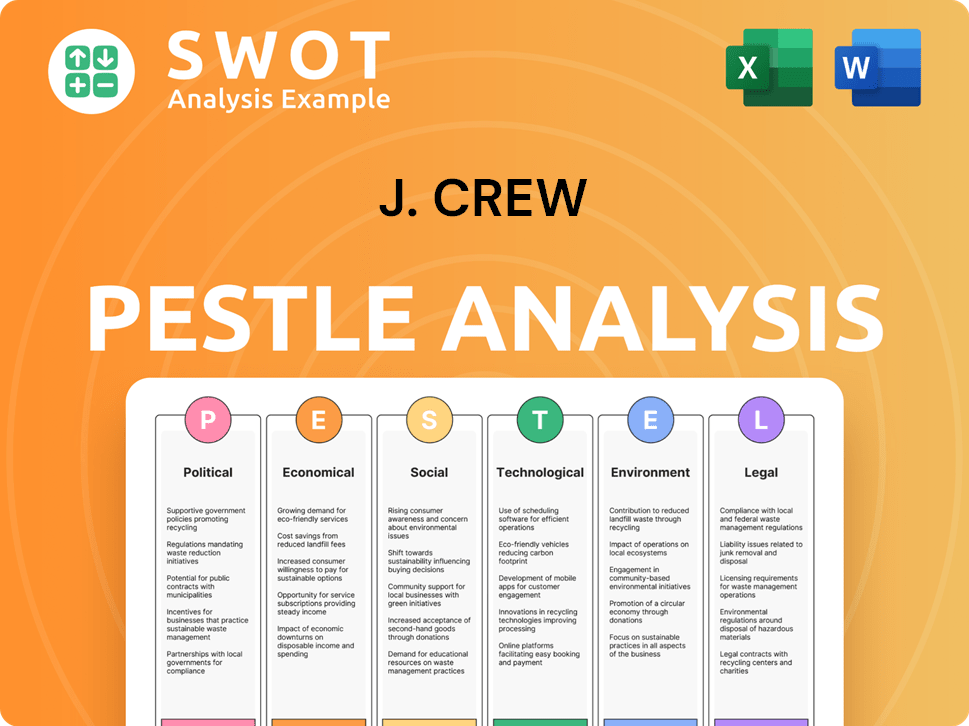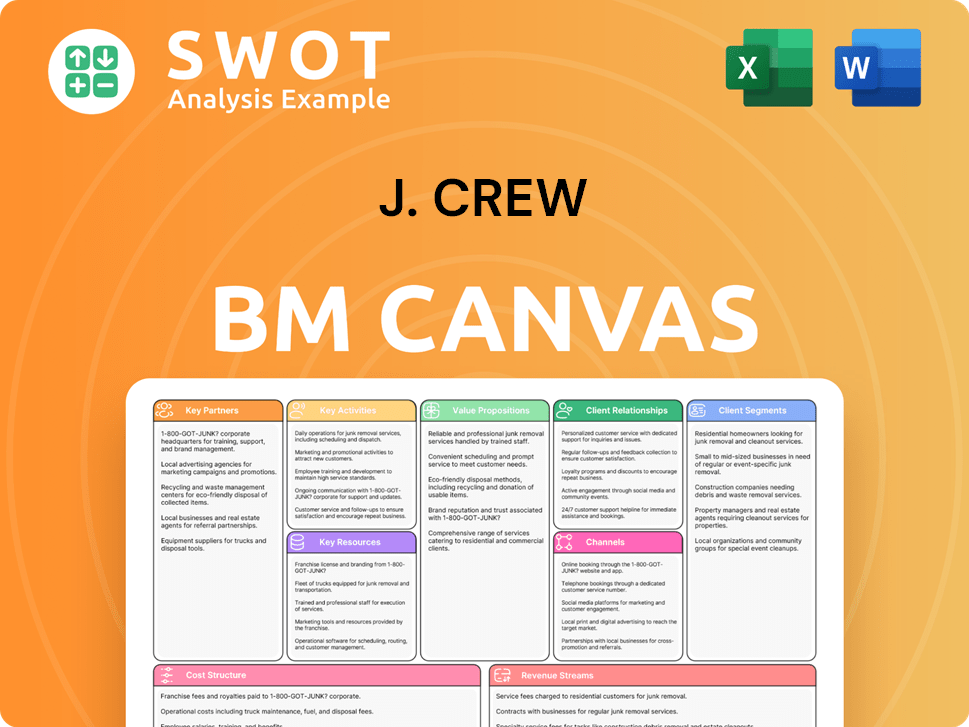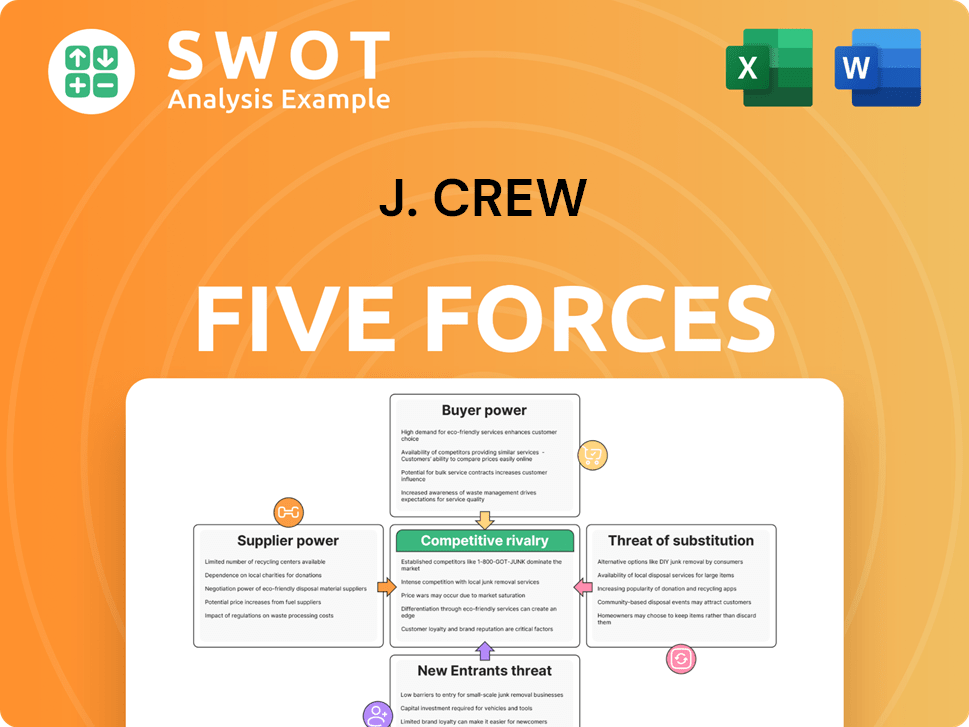J. Crew Bundle
Can J. Crew's Comeback Teach Us a Thing or Two About Retail Strategy?
From catalog darling to bankruptcy and back, J. Crew's journey is a masterclass in brand reinvention. This iconic American retailer, once a staple of "smart casual" style, has defied the odds, achieving record-breaking sales in 2024. But how did they do it?

This article unveils the secrets behind J. Crew's remarkable resurgence, focusing on its revamped J. Crew SWOT Analysis and sales and marketing strategies. We'll explore their innovative marketing tactics, including their successful return to the catalog format, and dissect how they've re-engaged their target market. Discover how J. Crew's current business model and strategic shifts are driving growth, offering valuable insights for businesses navigating the ever-evolving retail landscape, including a deep dive into their digital marketing strategy, customer acquisition strategies, and competitive analysis.
How Does J. Crew Reach Its Customers?
The J. Crew Group employs a multi-channel sales strategy to reach its customers. This strategy includes physical stores, e-commerce platforms, and, historically, catalogs. The approach allows the company to cater to diverse consumer preferences and shopping behaviors, optimizing its market reach. Understanding the Brief History of J. Crew is crucial for grasping its evolution in sales and marketing.
The company's primary sales channels consist of brick-and-mortar stores, e-commerce websites, and wholesale partnerships. The physical stores provide a tangible experience, while e-commerce offers convenience. Wholesale partnerships expand the brand's reach through other retailers. This integrated approach is a key element of the J. Crew business model.
The company's digital adoption has accelerated, especially after the COVID-19 pandemic. E-commerce is a crucial channel, with the company's online activity reaching US$1041 million in 2024. Online platforms offer features like personalized recommendations and a user-friendly interface. This digital focus is a significant part of J. Crew's marketing strategy.
J. Crew operates a network of physical stores across the United States and internationally. These stores serve as showrooms where customers can experience products. As of November 2024, there are 112 J. Crew retail stores, 154 Madewell stores, and over 300 J. Crew Factory stores.
E-commerce is a crucial channel for J. Crew, with online sales reaching US$1041 million in 2024. The company's websites offer a seamless shopping experience. Features include personalized recommendations and a user-friendly interface. This is a key component of J. Crew's digital marketing strategy.
J. Crew engages in wholesale partnerships with department stores and specialty retailers. This expands the company's reach. This strategy helps increase market appeal. These partnerships are part of J. Crew's overall sales strategy.
The reintroduction of the print catalog in Fall 2023 was a strategic move. It aimed to tap into nostalgia and offer a different touchpoint. This is an example of J. Crew's marketing campaign examples. It provides a targeted marketing approach.
J. Crew's sales strategy combines physical stores, e-commerce, and wholesale partnerships. This multi-channel approach caters to diverse consumer preferences. Digital adoption and the reintroduction of catalogs show the company's adaptability.
- Multi-channel approach: Physical stores, e-commerce, and wholesale.
- E-commerce growth: Online sales reached US$1041 million in 2024.
- Strategic shifts: Digital adoption and catalog reintroduction.
- Brand diversity: J. Crew, Madewell, and J. Crew Factory brands.
J. Crew SWOT Analysis
- Complete SWOT Breakdown
- Fully Customizable
- Editable in Excel & Word
- Professional Formatting
- Investor-Ready Format

What Marketing Tactics Does J. Crew Use?
The company's marketing strategy is a blend of traditional brand values and modern techniques. It focuses on storytelling and lifestyle branding, using a mix of digital and traditional tactics to build awareness, generate leads, and drive sales. This approach is crucial for reaching its target market and maintaining a strong brand presence.
The company leverages various digital channels, including social media, email marketing, and influencer partnerships. Data-driven marketing is a key component, with customer data used to create personalized experiences. This strategy aims to increase customer engagement and conversion rates.
Traditional media, such as print catalogs, still play a role in the company's marketing mix. Sustainability initiatives also serve as a marketing tactic, aligning with consumer preferences for ethical and environmentally friendly products. Strategic collaborations are another key tactic to expand reach and appeal.
The company uses social media, email marketing, and influencer partnerships. They focus on data-driven marketing to create personalized experiences. This approach aims to increase conversion rates and customer engagement.
Customer data is used to deliver tailored experiences, such as personalized email marketing and customized product recommendations. Analyzing browsing behavior and past purchases helps create a unique shopping experience. This may lead to a conversion rate increase of 15-20%.
The company invests in its mobile app, offering app-only promotions and early access to sales. This strategy incentivizes digital shopping. The goal is to boost online sales performance.
The company is focusing on boosting engagement through creative content on platforms like Instagram. The aim is to rekindle its 'prep' identity. This is a key part of their digital marketing strategy.
The strategic relaunch of its print catalog in Fall 2023 combined magazine-style storytelling with product layouts. This taps into nostalgia and appeals to a desire for tangible content. Direct mail advertising had the highest ROI in 2023.
Sustainability initiatives, such as the 'Re-imagined by the company' program, serve as a marketing tactic. The company aims to sustainably source 100% of key fibers by 2025 and eliminate virgin plastic from packaging by 2025. This aligns with consumer preferences.
The company's marketing strategy includes a mix of digital and traditional tactics, with a focus on data-driven personalization and sustainability. These strategies contribute to the company's overall Growth Strategy of J. Crew.
- Data-driven marketing to personalize customer experiences.
- Strategic relaunch of print catalogs to engage customers.
- Sustainability initiatives to appeal to environmentally conscious consumers.
- Collaborations with designers and influencers to expand reach.
- Focus on boosting social media engagement through creative content.
J. Crew PESTLE Analysis
- Covers All 6 PESTLE Categories
- No Research Needed – Save Hours of Work
- Built by Experts, Trusted by Consultants
- Instant Download, Ready to Use
- 100% Editable, Fully Customizable

How Is J. Crew Positioned in the Market?
The brand positioning of J. Crew centers on classic American style, emphasizing quality and craftsmanship. This approach sets it apart from fast-fashion competitors. J. Crew aims for approachable luxury, offering versatile pieces suitable for various settings. This strategy is crucial for its overall J. Crew sales strategy.
The brand's core message focuses on timelessness and quality, appealing to a specific demographic. This focus on quality materials and craftsmanship is a key element of the J. Crew brand identity. J. Crew's visual identity and tone of voice are consistent across all platforms.
In 2024, J. Crew's brand value was estimated at $1.2 billion, demonstrating its strong brand recognition and heritage. This brand value reflects the success of its J. Crew marketing strategy. The brand's commitment to sustainability further enhances its image.
J. Crew primarily targets middle to upper-middle-class consumers. The J. Crew target market typically includes young to middle-aged adults, aged 25 to 45. The brand's appeal is slightly skewed towards female consumers.
J. Crew maintains brand consistency across all channels. This includes physical stores and e-commerce platforms. The aim is to provide a seamless brand experience.
J. Crew is committed to sustainability. They aim to source 100% of key fibers sustainably by 2025. The brand also plans to eliminate virgin plastic from packaging by the same year.
J. Crew adapts to changing consumer preferences. The brand expands its offerings, such as activewear and swimwear. Strategic collaborations are also part of this strategy.
The company's ability to diversify its appeal while retaining its core identity is evident in its sub-brands. For more details on the specific consumer groups, you can explore the Target Market of J. Crew.
J. Crew's visual identity reflects a classic aesthetic. Seasonal lookbooks and curated collections emphasize aspirational living. This approach is central to the brand's appeal.
A thorough J. Crew competitive analysis involves understanding its rivals. This includes assessing their strategies and market positioning. The brand differentiates itself through quality.
The introduction of sub-brands like Madewell and J. Crew Factory demonstrates diversification. Madewell targets a younger demographic with a casual focus. J. Crew Factory offers more affordable styles.
J. Crew's digital marketing strategy includes e-commerce and social media. The brand utilizes online platforms to engage with customers. This approach supports its overall sales goals.
Understanding J. Crew's market share and growth is crucial for assessing its performance. The brand's ability to adapt and innovate influences its market position. Analyzing sales performance is important.
Details about J. Crew's loyalty program details can provide insights into customer retention. These programs can help enhance customer engagement. The brand's focus is on building customer relationships.
J. Crew Business Model Canvas
- Complete 9-Block Business Model Canvas
- Effortlessly Communicate Your Business Strategy
- Investor-Ready BMC Format
- 100% Editable and Customizable
- Clear and Structured Layout

What Are J. Crew’s Most Notable Campaigns?
Recent marketing campaigns by the company have been pivotal in re-establishing its brand identity and reconnecting with its core customer base. The focus has been on leveraging nostalgia and forming strategic collaborations to boost its J. Crew brand image. These efforts aim to strengthen the J. Crew sales strategy and enhance its market position.
A key element of the strategy involves tapping into nostalgia, particularly among Gen X and Millennials. The brand relaunched its iconic print catalog in Fall 2023, seven years after it was discontinued. This 'magalog' approach combined magazine-style storytelling with product layouts. This initiative was designed to resonate with multiple generations, including Gen Z, who appreciate '90s and Y2K styles. Direct mail advertising, as of 2023, had the highest return on investment compared to other ad campaign mediums.
Another significant component of the J. Crew marketing strategy is strategic collaborations. These partnerships aim to expand brand reach and appeal to new customer segments. The company actively engages with brands from different industries, creating limited-edition collections and co-branded products.
The relaunch of the print catalog in Fall 2023 was a major campaign to tap into nostalgia. This 'magalog' featured figures like actress Demi Moore. The campaign aimed to appeal to Gen X, Millennials, and Gen Z.
Partnerships are a key part of the marketing efforts. Collaborations with influencers boosted social media engagement by 30% in 2024. Partnerships with brands like Liberty London created limited-edition collections.
The 'Passport' loyalty program, launched in August 2022, rewards repeat customers. It offers perks and early access to sales. This builds customer loyalty and fosters direct engagement.
Frequent sales events are crucial for driving immediate sales. J. Crew Factory had 'Buy 1 get 2 Free' clearance events in August 2024. Discounts up to 70% off clearance were offered in December 2024.
The 'Passport' loyalty program, introduced in August 2022, is another significant initiative. This program rewards repeat customers, fostering customer loyalty. Furthermore, promotional campaigns are essential for driving sales. J. Crew Factory and its sister brand Madewell consistently offer sales to attract price-conscious consumers. These strategies are vital for the J. Crew business model and maintaining a competitive edge. For more insights, you can explore the Owners & Shareholders of J. Crew.
The catalog relaunch was successful in generating buzz. It also improved full-price sales, which had been a challenge. This demonstrates the effectiveness of direct mail.
Collaborations expand brand reach and appeal. The partnership with a lifestyle influencer in 2024 boosted social media engagement. These partnerships drive sales and brand awareness.
The loyalty program builds a direct line to the most engaged audience. It fosters customer loyalty. This program is crucial for customer retention.
Sales promotions drive immediate sales and attract consumers. Madewell offered discounts up to 78% off denim in December 2024. These events are critical for revenue.
The combination of nostalgia, collaborations, and loyalty programs aids in customer acquisition. These strategies help to attract new customers. This is essential for growth.
These campaigns are part of a larger effort to re-establish the brand. They aim to reconnect with the core customer base. This is key to long-term success.
J. Crew Porter's Five Forces Analysis
- Covers All 5 Competitive Forces in Detail
- Structured for Consultants, Students, and Founders
- 100% Editable in Microsoft Word & Excel
- Instant Digital Download – Use Immediately
- Compatible with Mac & PC – Fully Unlocked

Related Blogs
- What are Mission Vision & Core Values of J. Crew Company?
- What is Competitive Landscape of J. Crew Company?
- What is Growth Strategy and Future Prospects of J. Crew Company?
- How Does J. Crew Company Work?
- What is Brief History of J. Crew Company?
- Who Owns J. Crew Company?
- What is Customer Demographics and Target Market of J. Crew Company?
Disclaimer
All information, articles, and product details provided on this website are for general informational and educational purposes only. We do not claim any ownership over, nor do we intend to infringe upon, any trademarks, copyrights, logos, brand names, or other intellectual property mentioned or depicted on this site. Such intellectual property remains the property of its respective owners, and any references here are made solely for identification or informational purposes, without implying any affiliation, endorsement, or partnership.
We make no representations or warranties, express or implied, regarding the accuracy, completeness, or suitability of any content or products presented. Nothing on this website should be construed as legal, tax, investment, financial, medical, or other professional advice. In addition, no part of this site—including articles or product references—constitutes a solicitation, recommendation, endorsement, advertisement, or offer to buy or sell any securities, franchises, or other financial instruments, particularly in jurisdictions where such activity would be unlawful.
All content is of a general nature and may not address the specific circumstances of any individual or entity. It is not a substitute for professional advice or services. Any actions you take based on the information provided here are strictly at your own risk. You accept full responsibility for any decisions or outcomes arising from your use of this website and agree to release us from any liability in connection with your use of, or reliance upon, the content or products found herein.